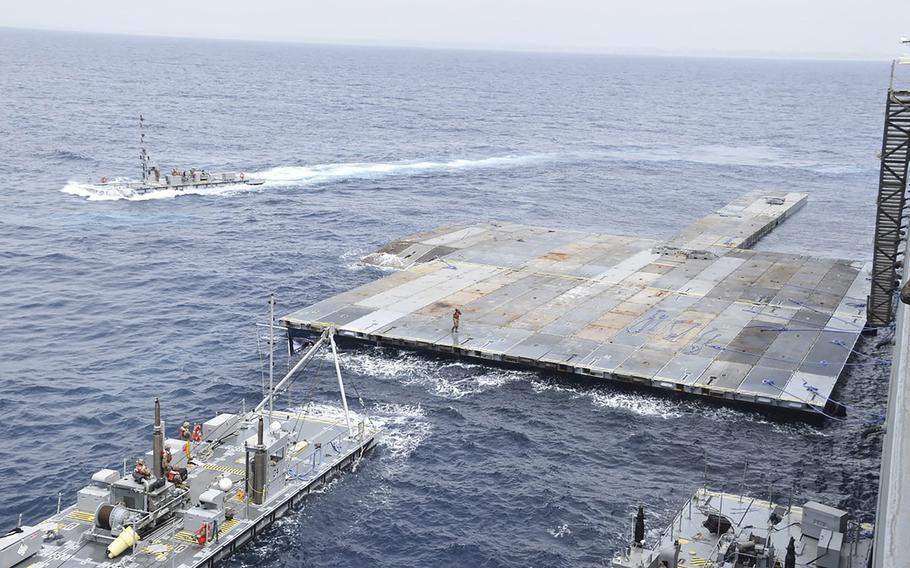"As of today, the construction of the two portions of the JLOTS — the floating pier and the Trident pier — are complete and awaiting final movement offshore,” Deputy Pentagon Press Secretary Sabrina Singh told journalists on May 8, using an acronym for Joint Logistics Over-the-Shore — the official name for the pier capability.
US Central Command “stands by to move the pier into position in the near future,” she added.
The US President Joe Biden has also announced that he will soon start using the sea pier to send aid to Gaza.
This floating pier, whose construction began last month and cost over $320 million, is the first major use of a sea route to send aid to Gaza since the start of the Israeli invasion of the Gaza Strip.
The US Department of Defense said that it is coordinating logistics with the Israeli army in Cyprus and the shipments will be inspected by an Israeli general based in this country.
Despite American claims bout the humanitarian goals of this pier and cooperation with the World Food Program (WFP) of the United Nations, the officials of this organization have announced that the plan is still in the "preparation stage" and that they have not seen signs of existence of plan for storage, protection, and distribution of the so-called humanitarian aid after unloading on Gaza coast.
WFP spokesman Martin Penner said the UN would work with Washington on the proposed maritime corridor provided that the United Nations' concerns about neutrality and security are addressed and land access is expanded.
A senior UN official, for his part, said: "If we are expected to receive and unload shiploads of humanitarian aid, which we certainly welcome, we just want to know how we are expected to accomplish this mission."
The pessimism surrounding the US claims of aid to Gaza and the secret intentions of the White House stem from the relentless American support to the Israeli regime that by shutting down all the humanitarian land routes is denying aid and weaponizing hunger against the civilians.
The Israelis even target the small amount of aid that is allowed in Gaza. In February, over 100 Palestinian civilians awaiting food distribution were killed by the Israeli direct fire. The Israelis also target the crew of the UN and foreign aid organizations. According to figures, over 200 aid workers, including 7 members of World Central Kitchen, were killed by Israeli military.
Also, according to details leaked to media, even after preparation and operation of the pier, the amount of aid will remain fixed for some time since Cyprus transportation pier is capable of shipping only 8,000 pallets daily. According to officials, the pier will initially allow about 90 trucks of humanitarian aid to enter Gaza daily, and that number will soon increase to 150 trucks a day, an amount that only meets the needs of 2.2 million people living in Gaza for a few days.
In the latest food classification of the situation in Gaza, the UN identified the region as being in the "famine" stage.
The United Nations uses strict criteria to declare famine in a particular region and relies on statistics from its two specialized agencies in this field, namely the WFP and Food and Agriculture Organization (FAO).
According to the integrated stage classification of food security, famine is the most dangerous stage in the acute scale of food insecurity, which consists of five stages:
First step: "Minimal" food insecurity
Second stage: "Stressed" acute food insecurity
The third stage: "Crisis" acute food insecurity
Fourth stage: "Emergency" acute food insecurity
Fifth stage: "Catastrophe" or "Famine"
The UN considers one of the impacts of the famine stage to be the possibility of death of 10,000 people, in which case the WFP says regarding Gaza: "Deaths are increasing, but the number available is limited, as is usually the case in conflict zones."
This comes while even aid airdropping failed to make any difference to the catastrophic food and humanitarian situation in Gaza, and this triggered pessimistic views and questions about the US pier.
For its part, Hamas has said that it will treat the US forces active in the pier as occupation forces, saying that it is a plot that serves the Israeli interests and is against people of Gaza.
The floating pier also faces complicated environmental challenges. Military officials have warned that turbulent waters of the Mediterranean will damage the sea structure and make it unsafe for personnel and people.
The pier, a justification for Rafah occupation
The important point is that announcement of completion of the pier comes at a sensitive time, namely start of Rafah invasion and threats to two key aid border crossings in this part of Gaza.
Everybody knows that capacity of a makeshift pier under the Israeli control with many challenges is way limited in comparison to the capacity of land crossings that provide a cheaper and more effective way of aid delivery.
During the seven months of war, the Israelis have sought a way to take control of Rafah border crossing and Philadelphi Corridor (also Salahuddin Corridor) to create a buffer zone between Egypt and Gaza, something that would allow them to control the only crossing out of their control for a more strict inspection and very likely heavier future pressures on the resistance groups.
Meanwhile, in addition to the failure to militarily advance
this project, the opposition from Egypt and international pressures
have so far kept the Israelis away from realizing this plan. But it
seems that despite the apparent opposition of Washington to the
occupation of Rafah crossing, the US administration has given Tel Aviv a
green light to sieze the key border crossing in order to put pressures
on the resistance groups and eliminate them from the future equations,
and opening the pier with the aim of easing the world sensitivity to the
dire impacts of Rafah occupation is another piece of this dangerous
puzzle.
/129

